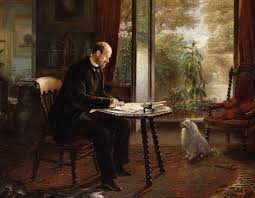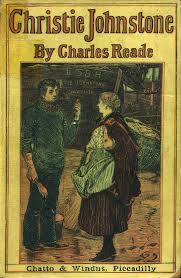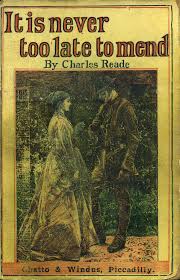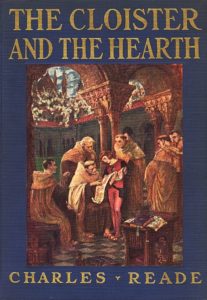The early life of English Novelist Charles Reade

One of the famous English novelist and dramatist, Charles Reade was born at Ipsden, England. He was the youngest son of Oxfordshire squire, John Reade and mother Anna Maria Scott Reade, on 8th of June 1814(twelve months before waterloo).
Till the age of seventeen, he was sent to a private school and had cruel experiences. But in 1835, due to his English essay which was above average, he gained a B.A. demy ship at Magdalen College, Oxford, but treated the position as a sinecure. His name was entered at Lincoln’s Inn in 1836, was elected as Vinerian Fellow in 1842 and was also invited to the bar in 1843 but never practised law.
He then became dean of arts and vice-president of Magdalen College, completing his degree in D.C.L. in 1847 and years later he became a partner in the business of Soho violin. It was in 1849 that he decided his career to be of a dramatist, theatre manager and novelist.
It was his wish that the word “dramatist” should come first in his occupational description on his tombstone. He believed that he was dramatist first and then a novelist, not merely because of the chronology but because as a dramatist and as an author he always had an eye to stage-effect in not only his scenes but also in his dialogues.
Famous works of Charles Reade
Charles Reade wrote different genres like adventure, history, romance etc. but most of his work was out of indignation and was about social injustices to humans. He was concerned about the social injustices present in society. He wanted to bring reform through awareness with the help of art, literature and education.
His first comedy play was ‘The Ladies’ Battle’ which was performed at the Olympic Theatre in 1951. He then wrote ‘Angelo’ (1851, Olympic theatre), ‘A Village Tale’ (1852, Strand Theatre), ‘The Lost Husband’ (1852, Strand Theatre), and ‘Gold’ (1853, Royal Olympic Theatre). It was after ‘Masks and Faces’ that Reade made his reputation in the literary world.
Masks and Faces
It was written in collaboration with Tom Taylor, who was an English dramatist and critic and was one of the editors of Punch magazine. The play was first performed in 1852 and at the end of the year, it was played 103 nights at the Haymarket and Adelphi Theatres.
The play is a historical British comedy starring Peg Woffington (Irish character) and Covent Garden. It is about the literal translation of its title masks on faces. It talks about the masks people put while covering their original facade and they’re real themselves.
In the play, Peg rescues people a painter, a mistress, a wife and others from destitution. Woffington is portrayed as a Mother Teresa of the mumming profession. The play was a success and to give the star a tribute for his fortune from the play, Charles wrote a novel on Peg Woffington, published in 1853 which again was a major hit.
Christie Johnstone

His fame was at the beginning stage. After Peg Woffington, he wrote another of his hit novel Christie Johnstone published in 1853. This novel had a slightly different genre from his earlier works i.e. it was a romantic drama novel. It is a story of a rich young and handsome aristocrat Viscount Ipsden, who was betrayed in love.
His therapist advises him to relieve the poor Scottish fishing village and learn the lesson of life and humanity. There in the village, he meets Christie who is a young, attractive, intelligent highly moralistic woman. The twists and turns in the novel by the writer were of the typical Victorian era. It was said that the story was based on his real experiences.
In 1854, with Tom Taylor, Charles Reade produced several plays like Two Loves and a Life, and The King’s Rival and The Courier of Lyons (later titled as -The Lyons Mail). In 1855, he wrote Art, which was subsequently known as Nance Oldfield.
It’s Never Too Late to Mend

His most notable work, It’s Never Too Late to Mend novel which was published in 1856. The story is about a ferocious squire who plans a conspiracy against a lovely couple since he was obsessing for a young woman. He conspires against George fielding so that he can win the girl.
The squire frames George in a plan to send him in jail. In the meantime, Tom Robinson, a young man who tries to steal money is sent to jail. The novel is quite mysterious and thrilling in the first half wherein second Charles deals with the brutality towards the prisoners.
Charles brings out the issues that the people inside the prison has to live with, the mistreatment, the suffrage, the torture for petty crimes, the abuses by the Britishers. He writes about the injustices happening in the process of giving justice to the people and questions primarily the prisoners’ rights and the reforming abuses used in the prison.
His other five novels back to back starting with ‘The Course of True Love Never Did Run Smooth’ in 1857, ‘White Lies’ in 1857, ‘Jack of all Trades early’ 1858, ‘The Autobiography of a Thief’ in 1858, and ‘Love Me Little, Love Me Long’ in 1859. Charles started writing the story of White Lies as a translation of Auguste Maquet’s play Le Château de Grantier.
But later he adapted the story and wrote a novel which was published serially in the London Magazine as the manager and the producers declined the manuscript. He produced the adaption of this story on stage titled The Double Marriage in 1867.
The Cloister and the Hearth

In 1861 he started working on his upcoming serial “A Good Fight” which was published as a serial initially in the magazine Once a Week in the year 1859. But soon the serial ended abruptly because Charles fought with the proprietors of the magazine on the subject matter of an unmarried woman getting pregnant in the story.
And hence he had to create an unsatisfied ending for the serial. But he did not stop working on the piece and in 1861 his work was published as a novel titled The Cloister and the Hearth. It is a historical picaresque set in the later medieval period of Holland and Europe. The novel is considered as a greatest historical literature in English for which Charles used medieval writing style and archaic language even though the readers are from the nineteenth century.
The story revolves around a young scribe and Gerard Eliason who illuminates light and his love Margaret Brandt who is a daughter of a poor scholar. The narrator narrates the instances of several characters and historical personages who interact with them. Charles has tried to bring out the conflict in the life of a man while obligating to his family and church. He brings out the important question of the importance of family and their benefits and the rigid instructions of the holy church.
After experiencing the richness of the 15th-century language, he wrote another modern language novel titled ‘Hard Cash’ which was earlier titled as ‘Very Hard Cash’ (1863), in this novel he brought forward the abuses of private lunatic asylums.
Another of his famous works are ‘Foul Play’, published in 1869, is a melodramatic and staggering novel where a clergyman is falsely identified of crime and transported to Australia. He is shipwrecked with a woman exposing the truth.
Other of his famous novels are Put Yourself in His Place (1870), which deals with the trade unions, A Woman-Hater (1877), which again deals with trade unions commenting of the profession of women doctors, The Wandering Heir (1875), whose dramatic version which was performed on the stage was Tichborne Case.
Later Life and Death
From 1856 until she died in 1879, Laura Seymour, an actress, lived with him. There have been many guesses and stories about the relationship between the two but the most accepted truth is that Charles Reade admired her work and so as Laura did. In Laura’s speeches, Charles was only a business partner to her.
She used to believe herself as the mistress of the house but not to him. Many sources claim that she told Mr John Coleman that if Mr Reade asks her to marry her very polite answer to it would be no. it was nothing more than a platonic friendship. Laura was buried at St Mary’s churchyard.
Interestingly, it was Charles wish that both of them should be buried together in the same grave. After his death on 11 Apr 1884 (aged 69), he was too buried at St. Mary’s Churchyard at Willesden, London Borough of Brent, Greater London, England, in the same grave as Laura Seymour’s.
Mystically their story forms the basis of a poem by Sir John Betjeman, “A Willesden Churchyard”.